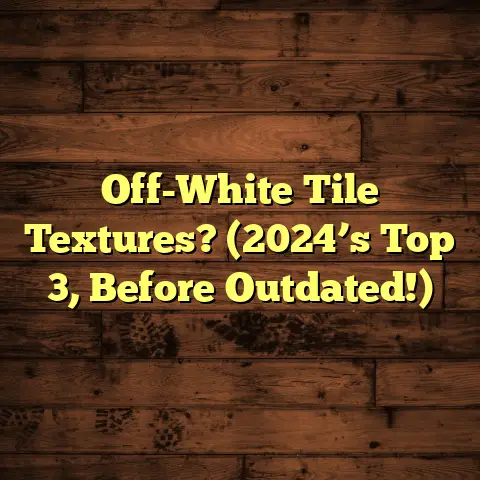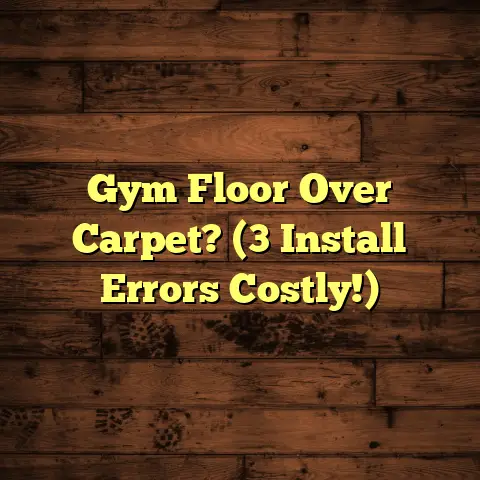Concrete Floorboard Replace? (4 Costly Errors!)
I’ve seen it all, from DIY disasters to stunning transformations.
And let me tell you, concrete flooring is having a MOMENT.
But before you jump on the bandwagon, or worse, start ripping up your existing floor, let’s talk about something important: sustainability.
We’re not just talking about looks here, we’re talking about the impact our choices have on the planet and our wallets long-term.
Replacing concrete floorboards might seem straightforward, but trust me, there are pitfalls.
I’m going to walk you through 4 costly errors I’ve seen homeowners make time and time again.
Avoiding these mistakes will save you money, headaches, and help you make a more sustainable choice for your home.
Let’s dive in!
The Rising Trend of Concrete Flooring
Overview of Concrete Flooring
So, what exactly is concrete flooring?
Simply put, it’s a floor made of concrete.
Surprise! But it’s not just your basic grey slab anymore.
Concrete flooring has exploded in popularity in both residential and commercial spaces.
Why? Because it’s incredibly versatile.
You can stain it, polish it, stamp it, and even add decorative aggregates.
The possibilities are endless.
Plus, it’s known for its longevity and ease of maintenance.
I’ve seen properly installed concrete floors last for decades with minimal upkeep.
Sustainability Angle
Here’s where it gets interesting.
Concrete can be a sustainable flooring option, but it’s not a given.
It depends on how it’s sourced and installed.
Think about it: concrete is made from cement, which is a major contributor to carbon emissions.
According to the Global Cement and Concrete Association, cement production accounts for around 8% of global CO2 emissions.
That’s HUGE!
But there are ways to mitigate this impact.
Using recycled materials in the concrete mix, like fly ash or slag, can significantly reduce the carbon footprint.
These materials are byproducts from other industries that would otherwise end up in landfills.
Also, concrete floors are naturally energy efficient.
Their thermal mass helps regulate temperature, reducing the need for heating and cooling.
This can lead to significant energy savings over the lifespan of the floor.
The Necessity of Replacement
When to Consider Replacement
Okay, so you’ve got concrete floors.
When is it time to consider replacing them?
Here are some common signs:
-
Cracking: Minor hairline cracks are normal, but large, deep cracks can indicate structural issues.
-
Moisture Issues: Discoloration, mold growth, or a musty smell can signal moisture problems underneath the floor.
-
Aesthetic Degradation: If your floor is severely stained, chipped, or just plain ugly, replacement might be the best option.
The lifespan of concrete flooring varies depending on the quality of the installation, the level of traffic, and the maintenance it receives.
I’ve seen some floors last 50+ years, while others need replacing after just 10.
It really depends.
Sustainability Considerations
Replacing concrete floorboards has an environmental impact.
Think about the energy required to demolish the old floor, transport the debris to a landfill, and manufacture new materials.
It’s not insignificant.
That’s why it’s crucial to choose sustainable materials and practices when replacing your floor.
Look for concrete mixes that use recycled aggregates or supplementary cementitious materials (SCMs).
Also, consider using low-VOC (volatile organic compound) sealers and finishes to minimize indoor air pollution.
There are certifications like LEED (Leadership in Energy and Environmental Design) and Green Globes that can help you identify sustainable flooring products.
These certifications assess the environmental impact of a product throughout its lifecycle.
The Costly Errors to Avoid
Alright, let’s get to the meat of the matter.
Here are the 4 costly errors I’ve seen homeowners make when replacing concrete floorboards:
Error 1: Skipping Proper Assessment
This is HUGE!
Before you even think about ripping up your floor, you need to thoroughly assess its condition.
I’m talking about more than just a quick glance.
You need to identify the root cause of any problems.
Is it a structural issue?
Is it moisture intrusion?
Is it simply cosmetic?
Overlooking minor issues can lead to more significant problems and costs down the line.
For example, if you have a moisture problem underneath your floor and you just cover it up with a new layer of concrete, the moisture will continue to cause damage.
You’ll end up with mold growth, cracking, and eventually, you’ll have to replace the floor again.
I recommend hiring a qualified inspector to assess the condition of your existing floor.
They can use specialized equipment to detect moisture, check for structural damage, and identify any other potential problems.
Error 2: Underestimating the Costs
Replacing concrete flooring can be expensive.
It’s not just the cost of the materials.
You also have to factor in labor, disposal fees, and any unexpected repairs that might arise.
Here’s a breakdown of the potential costs:
-
Demolition and Disposal: Removing the old floor can be labor-intensive and generate a lot of waste. Disposal fees can vary depending on your location.
-
Materials: The cost of concrete varies depending on the type of mix, the aggregates used, and the finish you choose.
-
Labor: Hiring a qualified contractor is essential for a successful installation. Labor costs can vary depending on the complexity of the project and the contractor’s experience.
-
Sealers and Finishes: You’ll need to seal and finish your new floor to protect it from stains and wear. The cost of sealers and finishes can vary depending on the type of product you choose.
-
Unexpected Repairs: You might encounter unexpected problems during the demolition process, such as damaged plumbing or electrical wiring.
I always tell my clients to add a contingency fund to their budget to cover these unexpected costs.
A good rule of thumb is to add 10-15% to your estimated budget.
Error 3: Choosing the Wrong Materials
Not all concrete is created equal.
Choosing the wrong type of concrete or flooring material can lead to premature failure of the floor.
For example, if you’re installing a concrete floor in a high-traffic area, you’ll need a stronger, more durable mix than you would for a low-traffic area.
You also need to consider the climate you live in.
If you live in an area with harsh winters, you’ll need a concrete mix that is resistant to freeze-thaw damage.
And don’t forget about aesthetics!
There are tons of different concrete finishes to choose from, each with its own unique look and feel.
Before you make any decisions, do your research.
Talk to your contractor, visit showrooms, and look at examples of different concrete floors.
And don’t be afraid to ask questions!
Error 4: Ignoring Professional Help
I get it. DIY projects can be fun and rewarding.
But replacing concrete flooring is not a DIY project.
Trust me on this one.
Improper installation can lead to a whole host of problems, including cracking, uneven surfaces, and moisture issues.
And those problems can be expensive to fix.
Hiring a qualified contractor is essential for a successful concrete floor replacement.
A good contractor will have the experience, equipment, and knowledge to install your floor correctly.
They’ll also be able to advise you on the best materials and finishes for your specific needs.
According to a study by the National Association of Home Builders, improper installation is one of the leading causes of flooring failures.
Don’t let that happen to you!
Conclusion
So, there you have it: 4 costly errors to avoid when replacing concrete floorboards.
Remember, sustainability is key.
By making informed decisions about materials and installation practices, you can create a beautiful, durable, and environmentally friendly floor.
Don’t rush the process.
Do your research, get multiple quotes, and hire a qualified contractor.
Your home and the environment will thank you for it.





